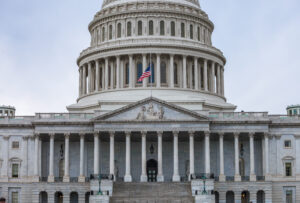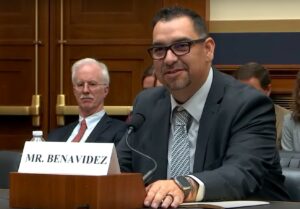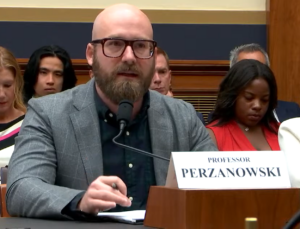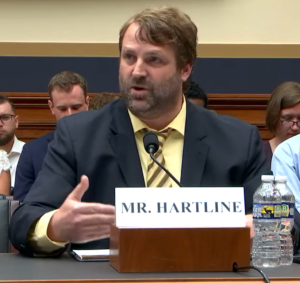
Congressional committee holds R2R hearing, ASA testifies federal law unnecessary
By onCollision Repair | Legal
With federal legislation once again before Congress, only two of the five witnesses that testified Tuesday said a nationwide law isn’t necessary.
During a hearing — titled “Is There A Right to Repair?” — in front of the House Judiciary Subcommittee on Courts, Intellectual Property, and the Internet Committee, the five witnesses shared their thoughts based either on their knowledge of patent and copyright law or within specific industries when it comes to the “right to repair.”
They were:
- Aaron Perzanowski, Thomas W. Lacchia Professor of Law, University of Michigan Law School;
- Devlin Hartline, Legal Fellow, Hudson Institute’s Forum for Intellectual Property;
- Kyle Wiens, iFixit co-founder and CEO;
- Scott Benavidez, Automotive Service Association chairman and Mr. B’s Paint & Body Shop owner; and
- Paul Roberts, SecuRepairs.org founder and Security Ledger founder/editor-in-chief.
Legislation before Congress includes the Right to Equitable and Professional Auto Industry Repair (REPAIR) Act(H.R. 906) and the Save Money on Auto Repair Transportation (SMART) Act. The latter is sponsored by the House Subcommittee’s chairman, Rep. Darrell Issa (CA-48).
Largely the basis of discussion during Tuesday’s hearing, the SMART Act would reduce the amount of time car manufacturers can enforce patent designs on repair parts against non-OEM parts suppliers from 14 years to 2.5 years. The bill is largely the same as previous versions introduced in prior sessions of Congress.
Supporters of the REPAIR Act claim it will ensure access to “all tools and equipment; wireless transmission of repair and diagnostic data; and access to on-board diagnostic and telematic systems needed to repair a vehicle.”
However, the request for in-vehicle data may not always be for the same objective as accomplishing the “right to repair (R2R).”
In a memo by the Alliance for Automotive Innovation (Auto Innovators), addressing a telematics ballot initiative in Maine, the alliance states, “Automotive right to repair already exists and always will. …Automakers agree and support numerous initiatives to facilitate seamless independent auto service and repair.”
The issue of right to repair has been a decades-long issue in the auto and collision repair, electronics, manufacturing, and agriculture equipment industries — just to name a few.
The debate picked up speed again in 2020 when Massachusetts voters passed a referendum that put new legislation on the books, the Data Access Law. It’s an extension of right to repair law that was already in place and calls for the creation of a “standardized access platform” for data generated, collected, and transmitted by vehicles.
In November 2020, Auto Innovators filed suit against Massachusetts to block the law arguing that it isn’t possible for automakers to meet its demands, federal law already in place preempts it, and it would pose cybersecurity risks.
Though the legislation became effective with the 2022 model year, Attorney General Maura Healey withheld enforcement as the legal challenge played out in court. New AG Andrea Campbell dropped that stipulation and began enforcement on June 1.
Maine voters will see a similar R2R question on their November ballot following a successful initiative by the Maine Right to Repair Coalition.
Last week, the Automotive Service Association (ASA), Society of Collision Repair Specialists (SCRS), and Auto Innovators affirmed a 2014 national memorandum of understanding (MOU) regarding R2R that, in part, states, “independent repair facilities shall have access to the same diagnostic and repair information that auto manufacturers make available to authorized dealer networks.”
In its joint letter sent to Congress, with a written agreement between the groups attached, the coalition wrote, “This commitment was created with our mutual and valued customers in mind: vehicle owners. It affirms that consumers deserve access to safe and proper repairs throughout a vehicle’s lifecycle [and] it is built to last because it anticipates changes in automotive technologies and market evolutions.”
Noted during Tuesday’s hearing, and in the letter to Congress from the coalition, the Federal Trade Commission already enforces R2R.
The letter says the FTC “has rightfully placed a focus on the repair options available to consumers for all the products they purchase — far beyond just automobiles. They have previously highlighted the automotive repair marketplace as a model for other industries to follow, noting it is ‘working well.’
“We agree! Today, 70% of post-warranty vehicle repairs today happen outside the dealer network, while automakers’ own certified collision networks are comprised of shops that are more than 70% non-dealer owned. In other words, competition is alive and well in
the auto repair industry.”
The coalition’s agreement was met with contentious disagreement from aftermarket industry associations, most of which say the agreement doesn’t change anything — they still won’t have the same access as OEM dealers to the procedures, tools, and equipment necessary to repair vehicles.
During the Congressional hearing on Tuesday, committee member Rep. Jerrold Nadler (New York-12) said he’s “deeply concerned to see the original equipment manufacturers react to the Massachusetts right to repair ballot measure by suspending access to telematic accessories for vehicles sold in the state.”
He asked Benavidez how the recent R2R agreement between repair shops and OEMs will affect consumer choice going forward.
“This agreement with the OEMs is great for us,” Benavidez said. “This is an agreement that we’ve worked on for a while to make sure that we have access to all information including telematics and anything coming forward. It’s in there, the commitment for both parties to support legislation if it needs to get there.
“But we would like this thing to stand on its own. This agreement has been needed for some time. We stand on the front lines of repairing these vehicles. We need this data and we have this data right now. We have zero repair shops asking us, ‘Hey, we don’t have the data. We can’t get the data. We don’t know how to fix it. We don’t have that right now.'”
Committee member Rep. Laurel Lee (Florida-15) asked what effect the passage of the SMART Act could have on insurance rates for consumers and if costs for parts and repairs would decrease because of increased consumer access.
“We can anticipate significant reductions in the expenses associated with auto collision repairs,” Perzanowski said. “Estimates are that design patents on collision parts are responsible for about $1.5 billion in additional expenditures. We see price premiums on OEM parts over third-party parts often reaching into the 40% range. There are pretty significant cost savings associated with that.
 “Part of this problem, I think, does relate back to the kind of unique structure of this market. Most consumers are not paying out of pocket for collision repairs. Those costs are being covered by their auto insurance provider. …I do think it’s important to note that the design patent issue for replacement parts is not limited to the automotive industry. I think that’s the area where the problem is most pressing.”
“Part of this problem, I think, does relate back to the kind of unique structure of this market. Most consumers are not paying out of pocket for collision repairs. Those costs are being covered by their auto insurance provider. …I do think it’s important to note that the design patent issue for replacement parts is not limited to the automotive industry. I think that’s the area where the problem is most pressing.”
Committee member Rep. Henry C. “Hank” Johnson (GA-04) asked how the 2014 MOU has worked in practice and if federal legislation is needed.
Benavidez said the MOU works and there’s no need for federal law and that ASA hasn’t had any shops “clamoring for data.”
Roberts disagreed. “We urgently need a federal version of the Massachusetts Law — the REPAIR Act,” he said. “This is not an urgent issue because most of the cars out there are older vehicles. As we move forward — as telematic systems evolve, as automakers continue their trend of moving more and more information to telematic systems — this is going to become a bigger problem.
“I’ll point out another problem, which is the law is contingent on data transfers of diagnostic and repair information via the OBD-II, or onboard diagnostic two, port under the dashboard. That’s only there because of federal Clean Air law. Electronic vehicles don’t have that port because they don’t have emissions.”
 Roberts contends that R2R legislation wouldn’t be a threat to cybersecurity and “can contribute to a healthier and more secure ecosystem of smart and connected devices proposed.”
Roberts contends that R2R legislation wouldn’t be a threat to cybersecurity and “can contribute to a healthier and more secure ecosystem of smart and connected devices proposed.”
“We have yet to find any evidence that the types of information covered by right to repair laws like schematic diagrams, service manuals, diagnostic software, and replacement parts act as a portal to cyber attacks,” he said. “The vast majority of attacks on internet-connected devices from broadband routers to home appliances to automobiles today exploit weaknesses in the embedded software produced and distributed by the manufacturers or alternatively weak device configuration.”
Earlier in his testimony, Benavidez said ASA fears the absence of quality standards required by the SMART Act could negatively impact the quality of replacement crash parts and thus, the safety of consumers. He told the committee that ASA members have made it clear that they want to keep access to the data necessary to repair their customers’ vehicles.
“The 1990 Clean Air Act amendments assured independent shops the same emission service information that was provided by automobile manufacturers to franchise car dealers,” he said. “In 2002, ASA signed an agreement with automakers stipulating that independent automotive repair shops would have access to the same emissions and non-emission service information provided to the manufacturers’ franchise dealerships.
“Since 2002, the vehicles Americans rely on have become increasingly sophisticated and we know that rate of innovation will only accelerate the way vehicle issues are diagnosed and repaired evolves in tandem with technological advancement… Newer vehicle technologies with an increasing number of sensors will present a challenge to our shops without access to the repair data. That’s why last week ASA proudly announced that it had reached a landmark agreement with the automakers that ensures independent repair shops can diagnose and repair their customers’ vehicles without hindrance from telematics nor any other innovation.”
Wiens, in support of R2R legislation, said Section 1201 (U.S. copyright law) needs to be fixed by Congress.
“We’ve been working on, on right to repair legislation in a number of states,” he said. “And in the last couple of years, Massachusetts passed auto right to repair and Colorado passed electric wheelchair and tractor right to repair. We passed a broad, sweeping consumer electronics right to repair in New York. And then Minnesota took it one step further, adding enterprise electronics and appliances. So, you’re seeing this spread across the country. California has a bill that is poised to pass very soon.”
Manufacturers that are against R2R, he said, argue concerns over consumer safety and privacy concerns.
“The U.S. is like this black hole where innovation is banned in software repair,” Wiens said.
Hartline testified that there isn’t a “right to repair.”
“A right is a legally enforceable claim against another. But the courts have not recognized that manufacturers have the duty to help consumers make repairs,” he said. “Instead, the courts have said that while we have the ability to repair our things we also have the duty not to infringe the IP [information provider] rights in the process. So it is in fact, the manufacturers who have the relevant rights, not consumers to right to repair.”
Perzanowski added that R2R has “emerged as a central challenge to the notion that we, as consumers, control the devices that we buy.”
“Instead, consumers, farmers, [and] small businesses all find that manufacturers exert post-sale control over these devices; often in ways that frustrate repair,” he said. “Repair is as old as humanity. Our paleolithic ancestors repaired hand axes and other primitive tools… manufacturers are employing a range of strategies that restrict repair from their hardware and software design choices to clamp down on secondary markets. And we also troublingly see attempts to leverage IP rights as tools to restrict repair.”
Perzanowski argues that the U.S. Copyright Office has already repeatedly established that diagnosis, repair, and maintenance activities are non-infringing when it comes to vehicles, consumer devices, and medical equipment.
“The right to repair is firmly rooted in basic principles of us IP law but IP law can and does continue to interfere with repair,” he said.
Images
Featured image credit: dkfielding/iStock
Secondary images: YouTube screenshots
